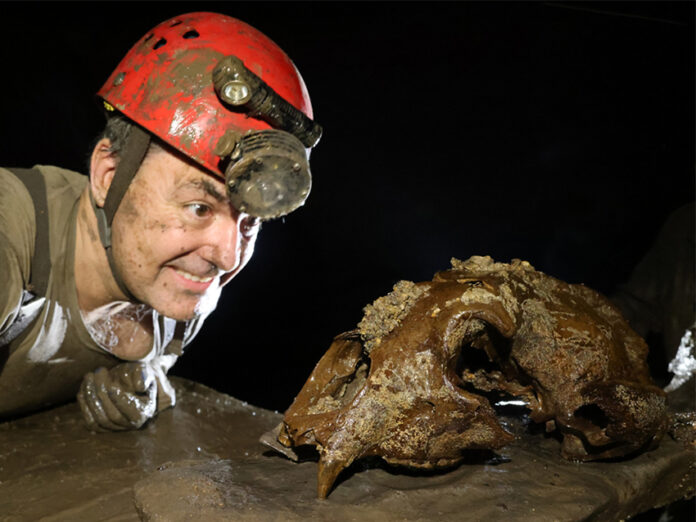Mammoths, saber-toothed tigers, camels, bison, glyptodons and gigantic five-ton sloths: all of them once roamed what today is called Mexico. The offbeat account of how the remains of these Ice-Age giants were discovered in a little-known and diabolically difficult cave is told in an award-winning, light-hearted documentary called “Crypt of the Megafauna.”
The story began in March of 2019, when cave biologist Luis Espinasa of New York’s Marist University, went to study cavefish in an underground stream passing through a little-known cave in the Sierra del Abra, in San Luis Potosí.

Blind cavefish
“I knew that both eyeless and eyed versions of the same fish, Astyanax — popularly known as the cave tetra — had been spotted in a small cave near Ciudad Valles,” Espinasa says. “It was a tiny cave, nothing more than a sinkhole leading to a pool where both morphs lived together. It looked like this cave would be an ideal place to study their behaviors and to witness the effects of natural selection.”
While exploring the Calera cave system, they discovered an entrance that led to virgin passage. Espinasa and his colleagues went in for a first look around.
The nightmare crawl
“After descending a vertical pit,” says Espinasa, “the passage was about a meter in height with a sandy floor and we crawled in on our hands and knees. Unfortunately, this soon transformed into a miserable belly crawl, with a ceiling height of only 40 centimeters (16 inches).”
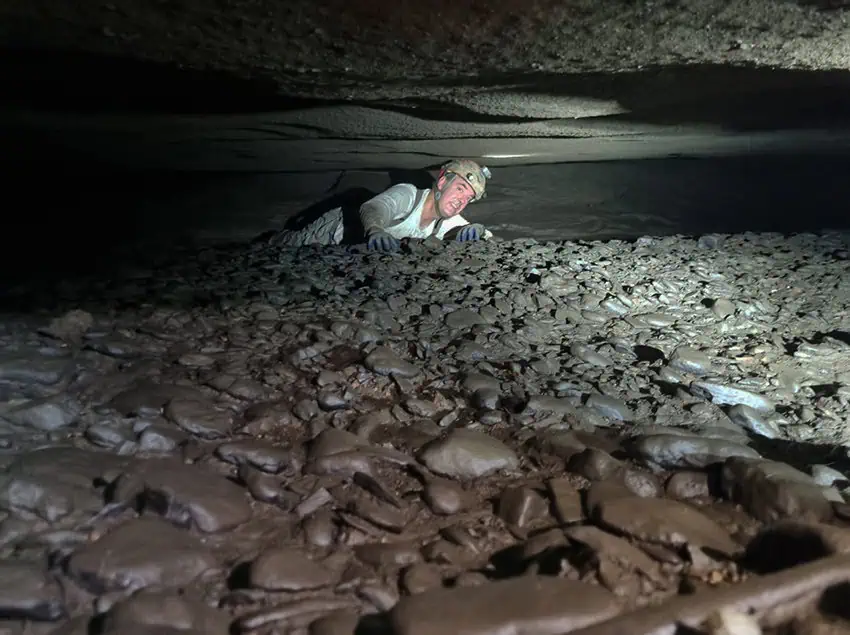
“But the low ceiling wasn’t the main problem. Instead of the comfortable sandy floor, the ground beneath was a nightmare of rough, spiky rocks, each movement sending sharp jolts of pain through your body. These rocks seem to have a malicious intent, digging into our skin with relentless determination. They offered no respite, no mercy, only an unyielding challenge to our endurance… and, unfortunately, for this first visit we had not bothered to bring along knee pads.”
The most important event of this first visit occurred in the entrance pool, but at the time, Espinasa paid it no attention.
A velvety black jawbone
“As I was swimming in the pool,” the biologist says, “I saw a massive jawbone half-buried in the silt of the cave floor. Its surface, once composed solely of bone, had undergone a remarkable process of fossilization, with minerals seeping into its very essence, encasing it in a delicate embrace of stone. The rich hues of manganese oxide cast the jawbone in an otherworldly sheen of velvety black.”
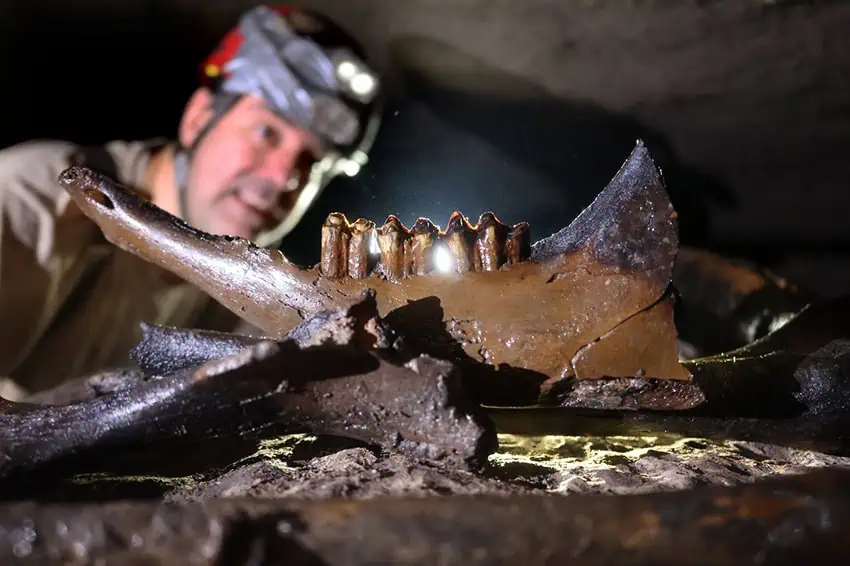
“In reality, I had in my hands a fossilized jaw of an ancient and extinct bison. But there are no bison in Mexico. So what did I do? I said to my fellow explorers, ‘A horse jaw… cool!’ and tossed it back nonchalantly into the pool.”
Espinasa found several unexplored passages, many of them littered with more of the velvety, black, fossilized bones. To survey what was turning into a complex system, he called in his brother, sister-in-law and niece, all expert cavers and proficient in cave mapping.
The mysterious molar
One day, deep inside the cave, Espinasa’s niece Sofía found a large rock with semi-circular, parallel ridges. Thinking it could be an ammonite, she took off her caving coverall, wrapped the rock in it, put it in her knapsack, and headed for the exit. Moving through the tight passages required lifting the heavy bag over and over, each time placing it an arm’s length ahead of her.
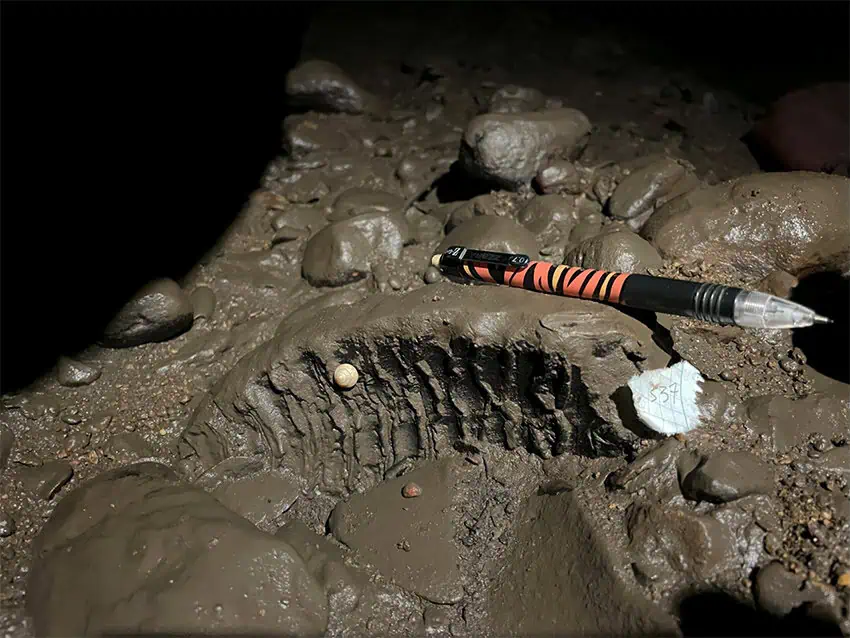
“She showed it to me,” comments Espinasa, “and I said, ‘Hmm, something about it does not look right to be a mollusk.’ Then, all of a sudden my brain clicked and I realized what it was. It had to be the molar of an elephant.”
But there are no elephants in Mexico and never have been. So what was an elephant molar doing in San Luis Potosí? It was at that moment that Espinasa realized that the molar had to belong to a mammoth and that the bones the team had noticed throughout the cave were not modern at all but actually fossils from Ice Age megafauna.
It was clear that what the team was now calling the Crypt of the Megafauna needed to be protected, but to convince the landowners and the local community — and, indeed, the whole world of its importance — they needed to collect and catalog more of its fossils.
Robo-Teddy to the rescue
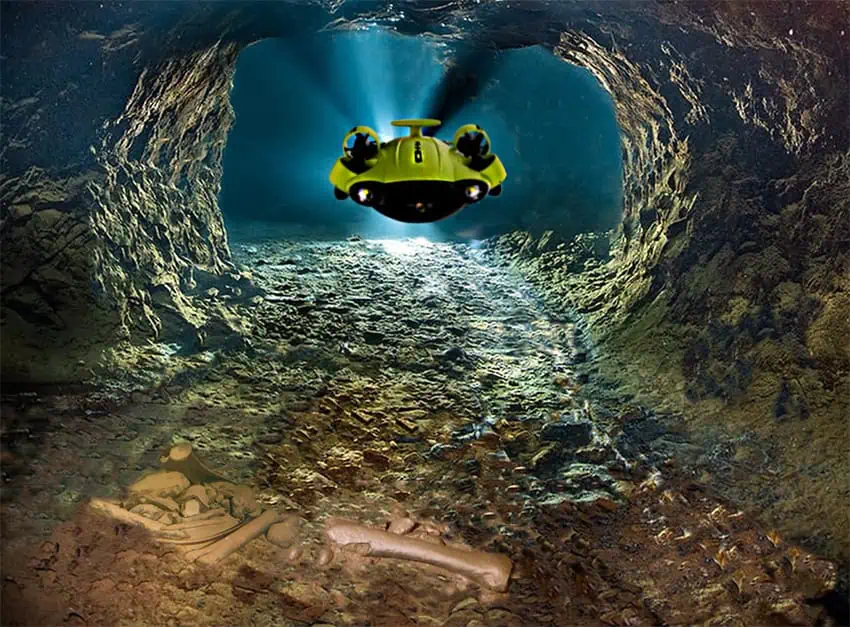
The problem was the cave. Some of the best-looking bones, for example, lay in a passage the team called El Arrastre Lodoso — the Muddy Crawl. This was 40 centimeters high. The floor was covered with sharp rocks as usual, but in this passage, all those rocks were coated with a thick layer of mud. Other promising galleries were filled with water. It was more than a human could handle.
This being the case, the team decided to bring in a small underwater drone with a claw capable of grasping and carrying a bone. They named it Robo-Teddy.
Thanks to Robo-Teddy and to a hair-raising scuba-diving endeavor, the explorers were able to catalog 775 specimens. These included parts of a saber-toothed tiger, a dire wolf, a glyptodon and a giant sloth that once weighed five tons and stood six meters high.
At one point, they found three vertebrae of an Ice Age bison. When they discovered that the three pieces fit together perfectly, they realized that the cave may have contained the complete cadavers of megafauna. An inevitable question arose: were human beings involved in the deaths of these creatures?
John Pint has lived near Guadalajara, Jalisco, for more than 30 years and is the author of “A Guide to West Mexico’s Guachimontones and Surrounding Area” and co-author of “Outdoors in Western Mexico.” More of his writing can be found on his website.
